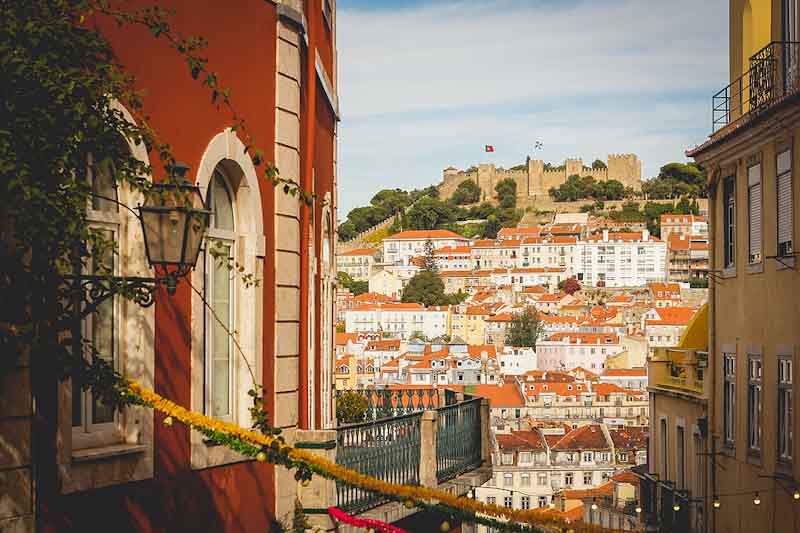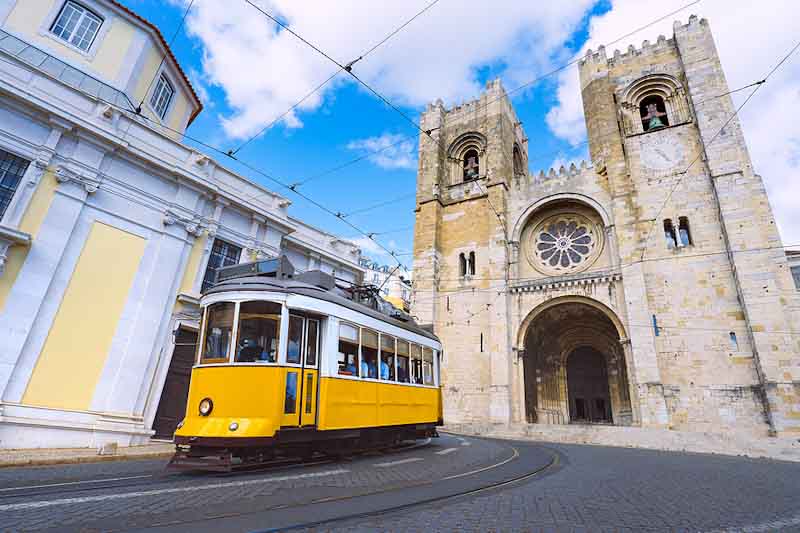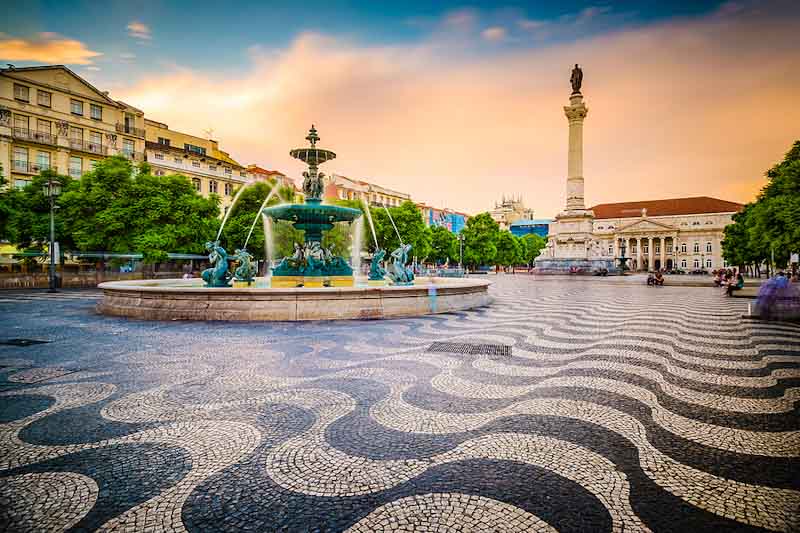Lisbon captivates many visitors with its mix of seafood, laid-back charm, and the Atlantic coast with sunny beaches and water sports. Here at the southwestern edge of Europe, Lisbon rises in a brilliant display of colors by the Atlantic Ocean. Compared to the other Latin countries on the European mainland, this is as far west as you can go and still enjoy the Latin lifestyle. Let us take a closer look at how you can enjoy Lisbon for three days. The endeavor is not to rush obstinately but instead take our time to experience a well-rounded Lisbon that stands out as being true to the soul of the city.
Tram or tuk it – You won’t be the only one
If you have 72 hours to spend in this vibrant city the trams will be a great way to get around in comfort. Additionally, by riding trams around the city, you get to see it from the local perspective. Sure enough, tram 28 is known for its route as it takes you through the districts Graca, Alfama, Baixa, and Estrela – All popular with tourists. But there is no need to limit yourself to that tram line, there are plenty of tram lines that you can jump on and off while taking in the impressions of Lisbon.
Explore Lisbon by Tuk-Tuk
You could also opt for the very popular visitor’s choice, namely a tuk-tuk ride with a guide to explore hidden spots. This is massively useful if you want to ride uphill towards the hill of our lady or towards the fortress. This city is full of narrow alleys and stone stairs between larger streets. It makes sense, considering that Lisbon is situated on seven hills and is the westernmost city in Europe. The graffiti art is seen high up on Alfama hill. You might also want to check out the cathedral Sé de Lisboa, which began construction in 1147, coincidently the same year that Lisbon was recaptured from the Moors. This may very well be the oldest building in the city. Into modern times, archaeology excavations in the cathedral have revealed finds, some dating back to Roman times. As you can see, a Tuk Tuk comes in handy for discovering the hidden parts of Lisbon. One such hidden curiosity is the narrowest stairs in the city (in Alfama) remain in place after the earthquake in 1755 that saw the old city demolished and paving way for a new city planning and design.
Stunning architecture born out of a disaster
The city was reconstructed after that earthquake in 1755 which left much of the old Lisbon destroyed. What followed was an intense reconstruction of the city. And churches are not the only place where you can find compelling architecture. Take in the local atmosphere as you walk down the streets in central Lisbon. Make sure to look up and to the sides to let your eyes feast on the tiled facades that the houses in Lisbon are known for.
Try the local culinary delights
The seafood in Portugal is in a class of its own. And this makes plenty of sense considering the local fisheries that exist. But don’t forget the local pastry pastel de nata, as they combine so well with the grilled sardines, Sardinhas Assadas.
Hills, hills everywhere!
Wherever you find yourself in Lisbon, chances are you will see a hill rising or falling. With a history that stretches back to the Romans and Moors, combined with its privileged location in the center of Portugal, it is clear how this evolved into a melting pot of traditions. And this is also where modern meets tradition. The city has a historically wealthy relationship with Brazil, and this is seen in the Brazilian community which is the largest immigrant community in Lisbon. Modern times also brought larger groups of Cape Verdeans, Romanians, and Angolans to the capital of Portugal.
A city with over 70 churches
There are more than seventy churches in Lisbon and they mix Baroque as well as Rococo Stucco and Gothic styles. Igreja de São Domingos is one example of many, which is one of the largest churches in Lisbon. Some churches have been around for centuries before the earthquake in 1755. For Gothic architecture buffs, the Jerónimos Monastery is well worth a visit. It is famous worldwide for the Manueline architecture which is the composite Portuguese style known as the Portuguese late Gothic style. The stoneworks associated with this style include elements from the sea, such as pearls and shells. Moreover, columns are carved twisted strands of rope and the distinctive semicircular arches are prominent as compared to the usually pointed Gothic arches.
Starting at the center
A handy starting point is Placa de Comercio and to go to Avandia da Liberdade which is almost a straight line heading north-northwest. At any point, take a right or left and you will stumble upon
If you want to go to a select few districts that define Lisbon, then you will find some right by the doorstep if you stay downtown close to the Placa de Comercio. Graca, Baixa, and Alfama are huddled close to each other in the center. The pedestrian streets are a treat, as you can find restaurants and cafes tucked away in alleys. For example, from the shopping street Placa de Comercio, you will find a score of alleys, all with their unique touch and restaurants dotting the cityscape.
Rossio Square
This square is one of the livelier spaces in the city. Two baroque-styled fountains adorn it with cafes and restaurants lining the side closest to the Old Town. This is a good place to sit and bask in the sun on a sunny day. As you walk around the square, don’t forget to throw a glance down to the tiles with the wavy patterns. In the 19th century, the cobblestone square was created in wave patterns. Over time this has spread to Portugal’s cities in former colonies Rio de Janeiro and Macao. It is all connected, as the saying goes. This is easily one of the liveliest parts of the capital in Portugal. That of course also means that this is where tourists flock, so you might not want to dwell too long here. However, it does have some monuments worth seeing and understanding to get a grip on what formed Lisbon in the last few centuries. For instance, the Column of Pedro IV of Portugal stands in the center.
The D. Maria II National Theatre was founded in 1842 and then replaced the older Estaus Palace which was the headquarters of the Portuguese Inquisition that had been standing since the 15th century.
Another defining piece of modern history in Lisbon is the Rosso Railway Station which was built in 1887. These few years before the turn of the century were part of the Railroad Era that had begun in Great Britain in 1830 and continued across the continent the following decades.
On the way to the waterfront, the Rua Augusta is lined with shops and restaurants. And it leads to the triumphal arch, Arco Triunfal da Rua Augusta. As you approach the arch, you can spy the city square Praça do Comércio as it opens up towards the harbor and the Tagus river. This is the old town square that was completely remodeled after the earthquake in 1755.
Climbing the tallest hill in Lisbon
The Lady of our Hill will give you the best and highest view of the city. To your left, the towering fortress will stand between you and the sea. Straight forward and to the right the rooftops are stretching out into the horizon.
As the sun sets over Lisbon that is also where you find the most impressive views of the city below. The notion that Lisbon is set on seven hills may cater to the imaginative minds, but in reality, the eighth hill is the one that gives you the most magical view of the city!
Fado in the Alfama district
The Alfama district presents itself with winding streets leading up, and further up. An evening with Fado music will be a phenomenal memory to bring back home. The singing and viola and guitar music will blend together with the soul of Lisbon. You have several Fado restaurants in the district, and they all open late for northern European standards. Being treated to Fado music after a hearty Portuguese meal is a special experience and something worthwhile to treasure a memory of.
Tram 28 up the hill from Martim Moniz to Campo Ourique
This is one of the most iconic trams in Lisbon. It takes you on a whirlwind trip through several districts, often through narrow streets where buses cannot pass. Moreover, tram 28 takes you through tourist districts from the west to the east in Lisbon, passing through the oldest of them, Alfama, and climbing up the highest district, Graça.
Because this tram line is so known it is also the busiest one. Therefore, if you want to enjoy it without it being crowded, go early one morning. Also, you have a better chance to grab a seat if you board the tram at Martim Moniz.
Facts: The hills in Lisbon and their appealing traits
- The São Roque hill has some of the most stunning views of the city, unfolding below the hill.
- The São Jorge hill has the city’s castle and you can view the city from Miradouro do Castelo.
- The Santo Andre hill has some very exciting examples of house tiles. This can be visited with tram 28.
- The Santa Catarina hill is a good choice for a sunset view.
- The Chagas hill has the elevator, the Elevador de Santa Justa. This opened in 1899 is built in Neo-Gothic style is a defining sign of the latter 19th century.
More inspiration for your trip to Lisbon
Letting gaze and palate feast in Lisbon and Sintra, in Portugal.
Paul-Christian Markovski, for EuropeZigZag.com.









